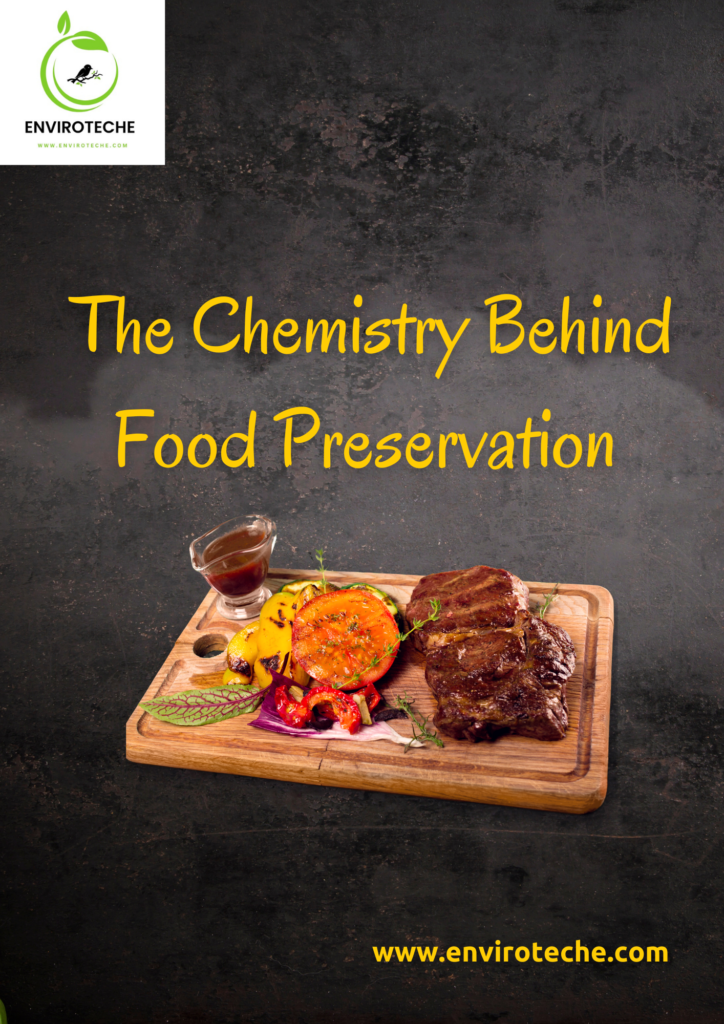Table of Contents

What is food preservation?
Preserving foods is the process of keeping food nutritious and secure for a long time. Properly packaged frozen, canned, and dry products are a few examples of preserved foods. Food preservation’s main goal is to prevent food from spoiling until it may be consumed (Knorr & Augustin, 2022). Some of the examples of preserved food are given below:
- Jams
- Jellies
- Dried fruits
- Pickles
- Bacon
- Pepperoni
- Canned tuna
What is food spoilage?
A change that makes food unfit for ingestion is considered food spoilage. These alterations could result from several things, such as food contamination by microbes, insect infestation, or endogenous enzyme breakdown (Rawat, 2015). Food deterioration may also be facilitated by chemical and physical modifications, including the breaking down of animal or plant tissue or oxidation of some food components.
The enzymes housed in plant and animal tissue cells may be released if postharvest examination results in any mechanical damage. The biological elements begin to dissolve as a result of these enzymes. The chemical processes that catalyze enzymes cause food quality to deteriorate, which includes the appearance of unpleasant odors, erosion of substances, and loss of nutrients. Contamination by Microbes:
Both bacteria and fungi are major contributors to food-borne diseases and the bacterial families that cause food to rot (Tournas, 2005). Any time food is being collected, preserved, processed, sent out, handled, or prepared, microorganisms have the potential to contaminate it. Soil, air, surfaces of plants, sewage, animal feed, skins of animals, and kitchen tools or utensils are the main sources of bacterial contamination.
Controlling Microbial Contamination:
The widely used techniques to prevent the growth of microbes include heating, removing water, lowering storage temperature, lowering pH, regulating oxygen and carbon dioxide stages, and removing nutrients that promote growth. Chemical preservative use is carefully regulated in the United States by governmental agencies like the Food and Drug Administration, or FDA. A chemical must first demonstrate its safety before it is used in food products, even though it may act as a preservative.
Enzymes that Cause Food Spoilage:
- Ascorbic acid oxidase: These enzymes cause spoilage in vegetables and cause the destruction of vitamin C.
- Lipase: It causes the spoilage of cereals, milk, and oils. It causes discoloration and hydraulic rancidity (Sahu & Bala, 2017).
- Lipoxygenase: Causes the destruction of Vitamin A and off-flavor in vegetables.
- Pectic enzyme: Causes the destruction of pectic substances and excessive softening in fruits and juices.
- Protease: Causes the reduction of shelf life of fresh and dried whole eggs, over tenderization in crabs and lobsters, and also causes the reduction of gluten formation in flour.
Conventional Methods for Food preservation:
Fermentation and Pickling:
Although microorganisms are typically associated with decomposition, they are capable of providing good outcomes under specific circumstances, such as oxidative and alcohol-based fermentation (Guizani, 2011). Acidity, the amount of accessible carbohydrates, air, and temp all affect how many microbes may develop in a food product and what kinds of changes they cause. A crucial food preservation technique combines fermentation to preserve the treated tissues with salting to control bacteria selectively.
Pickled fruits and Vegetables:
After 24 hours in a wet solution, fruits soften and start a gradual, mixed fermentation-putrefaction process. Salt suppresses undesired microbial activity, fostering the required fermentation in a favorable environment (Medina et al., 2016). You can pickle most fruits and vegetables to preserve them.
Pickled Meat:
Meat can be preserved using pickling liquid or dry curing. Sodium nitrate, sodium nitrite, sodium chloride, sweetness, and citric acid or vinegar are those substances used in pickling (Jespersen & Engman, 1977). The meat may be combined with dry ingredients, steeped in pickling solution, pumped into the flesh with pickling solution, or sometimes a combination of these things may be used.
Modern Food Preservation Techniques:
- Refrigeration: One of the most popular and basic techniques is this one. The freshness of food that is perishable is maintained by the sluggish growth of microbes and enzymatic reactions caused by cold temperatures.
- Freezing: Bacteria and other germs cannot thrive on food when it is frozen at extremely low temperatures, usually below -18°C (0°F). Vegetables, fruits, meats, and seafood all retain their quality very well using this procedure.
- Canning: Canning includes heating food to kill germs, yeast, and molds while sealing it in airtight vessels. Soups, sauces condiments, and fruits can all have their shelf lives extended with this technique.
- Pasteurization: Pasteurizing is a heat-based process that destroys dangerous germs while barely changing the food’s flavor or nutritional content. It is frequently used for fruit juices and milk.
- High-Pressure Processing (HPP): This method of processing employs high pressure to destroy germs and bacteria while keeping the food’s flavor and nutritional value. It is frequently employed for ready-to-eat meals and juices.
- Vacuum Packing: Vacuum packaging eliminates air from inside the container to stop oxidation and the development of bacteria that cause spoiling. It works for a variety of items, including cheese and meat.
Storage of food:
Food storage is a vital component of food preservation. While something is being stored, a food product is subjected to several processes that could diminish its quality. The nutritional value of food may be harmed by improper preservation. For instance, during storage, foods can lose a significant amount of thiamine or vitamin C. In addition to these undesirable quality modifications, storage can cause color alterations, the emergence of bad tastes, and texture loss. Fresh or processed food can be kept for a long time in a properly designed food storage system without losing any of its quality.
The temperature is the most crucial storage factor. Most food benefits from being stored at a stable, low temperature, where most of the reactions occur slowly and quality losses are reduced to the minimum.
Conclusion:
In conclusion, food preservation science is a complicated and varied area that uses a range of principles and procedures to guarantee the freshness and security of food products. Chemistry is essential for these processes, from regulating microbial growth to supervising enzymatic reactions and preserving food quality. It is essential for both food producers and consumers who wish to make educated decisions regarding the quality and safety of the foods that they ingest to understand how chemistry and food preservation interact. We can eat a variety of food while preventing food waste and enhancing food safety by understanding the research behind food preservation.
References:
Guizani, N. (2011). Vegetable fermentation and pickling. Handbook of vegetables and vegetable processing, 351-367.
Jespersen, K., & Engman, T. E. (1977). Process for pickling meat sections. In: Google Patents.
Knorr, D., & Augustin, M. A. (2022). Preserving the food preservation legacy. Critical Reviews in Food Science and Nutrition, 1-20.
Medina, E., de Castro, A., Romero, C., Ramírez, E. M., & Brenes, M. (2016). Safety of fermented fruits and vegetables. In Regulating safety of traditional and ethnic foods (pp. 355-367). Elsevier.
Rawat, S. (2015). Food Spoilage: Microorganisms and their prevention. Asian journal of plant science and Research, 5(4), 47-56.
Sahu, M., & Bala, S. (2017). Food processing, food spoilage and their prevention: An overview. Int. J. Life. Sci. Scienti. Res, 3(1), 753-759.
Tournas, V. (2005). Spoilage of vegetable crops by bacteria and fungi and related health hazards. Critical reviews in microbiology, 31(1), 33-44.
Author detail:
Aisha Ghaffar, Tayyba Shakir
Department of Chemistry, University Of Agriculture Faisalabad, Sub-Campus Toba Tek Singh
Check Other Scholarships:

